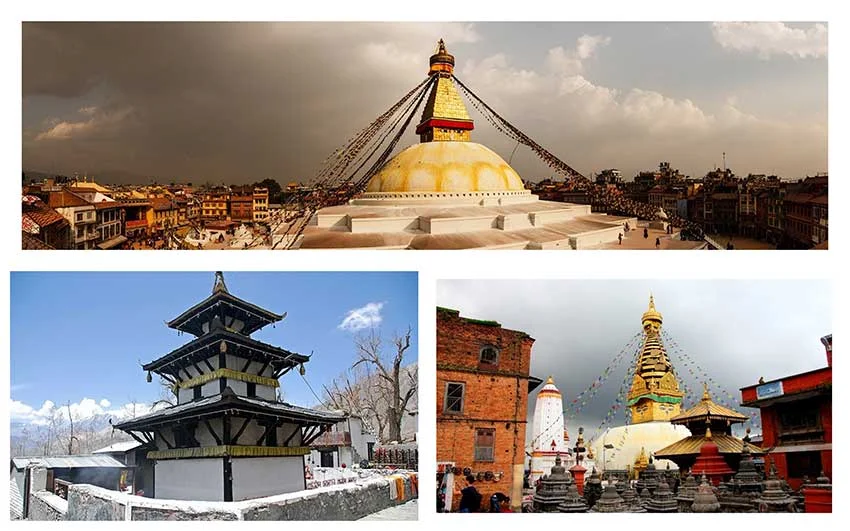Nepal, nestled in the lap of the Himalayas, is not just a land of breathtaking natural beauty but also a sacred space for millions of devotees. Known as the Land of Gods, Nepal boasts countless temples, monasteries, and shrines representing the profound spirituality of both Hinduism and Buddhism. From ancient pagodas in Kathmandu Valley to serene monasteries in Mustang, the country is dotted with sacred sites where history, culture, and devotion come alive. In this article, we take you on a spiritual journey to the most famous temples of Nepal, exploring their legends, architecture, rituals, and the experiences they offer.
Table of Contents
Famous Temples of Nepal
1. Pashupatinath Temple – The Abode of Lord Shiva
One of the most revered Hindu temples in the world, Pashupatinath Temple sits on the banks of the Bagmati River in Kathmandu. Dedicated to Lord Shiva, it is also a UNESCO World Heritage Site.
Highlights:
Built in the 5th century CE.
Only Hindus are allowed inside the main sanctum.
Maha Shivaratri festival attracts thousands of pilgrims.
Famous for its cremation ghats along the river.
Tip: Visit during early morning or evening for the enchanting aarti (prayer ceremony).
2. Swayambhunath Stupa – The Monkey Temple
Swayambhunath, also known as the Monkey Temple, is an iconic Buddhist stupa perched atop a hill in Kathmandu Valley. Its white dome and gilded spire adorned with Buddha’s eyes symbolize wisdom and compassion.
Highlights:
Believed to be over 2,500 years old.
Offers panoramic views of Kathmandu city.
Home to hundreds of playful monkeys.
Pilgrims circle the stupa chanting mantras and spinning prayer wheels.
3. Boudhanath Stupa – A Hub of Tibetan Buddhism
One of the largest stupas in the world, Boudhanath is the spiritual center for Tibetan Buddhists in Nepal.
Highlights:
Built in the 14th century.
A UNESCO World Heritage Site.
Surrounded by monasteries and vibrant markets.
Best visited at dusk when butter lamps light up the area.
4. Muktinath Temple – Salvation in the Himalayas
Located at an altitude of 3,800 meters in Mustang, Muktinath Temple is a sacred pilgrimage site for both Hindus and Buddhists.
Highlights:
Dedicated to Lord Vishnu (Hindu) and Avalokitesvara (Buddhist).
Known for 108 water spouts and eternal flame.
Pilgrims take a holy bath in freezing water for salvation.
Accessible via trekking routes or flights to Jomsom.
5. Manakamana Temple – The Goddess Who Grants Wishes
The Manakamana Temple, dedicated to Goddess Bhagwati (an incarnation of Parvati), is believed to fulfill the wishes of her devotees.
Highlights:
Located in Gorkha district.
Reachable by a thrilling cable car ride.
Stunning views of the Himalayas and valleys below.
Pilgrims often offer animal sacrifices as part of traditional rituals.
6. Changunarayan Temple – The Oldest Hindu Temple
Situated on a hilltop near Bhaktapur, Changunarayan Temple is dedicated to Lord Vishnu and is considered the oldest Hindu temple still in use in Nepal.
Highlights:
Dates back to the 4th century CE.
Beautifully carved wooden struts and stone inscriptions.
A UNESCO World Heritage Site.
Surrounded by a quaint village and terraced fields.
7. Janaki Mandir – The Temple of Goddess Sita
Located in Janakpur, Janaki Mandir is a magnificent temple dedicated to Sita (Janaki), the consort of Lord Rama.
Highlights:
Built in 1910 in a unique Mughal and Koiri architectural style.
Believed to be the place where Sita was found and married to Rama.
Pilgrims flock here during Ram Navami and Vivah Panchami festivals.
8. Dakshinkali Temple – Fierce Goddess Kali
Located 22 km south of Kathmandu, the Dakshinkali Temple is dedicated to the fierce Goddess Kali.
Highlights:
Known for animal sacrifices, especially during Dashain festival.
Nestled in a beautiful forest setting.
Devotees come to seek blessings for courage and protection.
9. Gosaikunda – Sacred Himalayan Lake and Temple
Gosaikunda, a high-altitude lake at 4,380 meters, is both a natural wonder and a religious site.
Highlights:
Believed to have been created by Lord Shiva’s trident.
Pilgrims visit during Janai Purnima festival.
Surrounded by snow-capped peaks and pristine wilderness.
10. Budhanilkantha Temple – The Sleeping Vishnu
Located just north of Kathmandu, Budhanilkantha Temple features a large statue of Lord Vishnu reclining on a bed of snakes in a pond.
Highlights:
Carved from a single block of black basalt.
Over 5 meters long and dates back to the 7th century.
Non-Hindus can view the statue from outside the enclosure.
Festivals Associated with Nepal’s Temples
Visiting temples during festivals amplifies the spiritual experience:
Maha Shivaratri at Pashupatinath.
Buddha Jayanti at Swayambhunath and Boudhanath.
Janai Purnima at Gosaikunda.
Ram Navami & Vivah Panchami at Janaki Mandir.
Dashain & Tihar at various temples across Nepal.
Tips for Visiting Temples in Nepal
- Dress modestly.
- Remove shoes before entering the sanctum.
- Be respectful of rituals and avoid photography where prohibited.
- Carry cash for donations or offerings.
- Visit early morning or late evening to avoid crowds.
Why Temples Are Important in Nepalese Culture
Temples in Nepal are not just places of worship but also centers of art, history, and community life. They showcase exquisite architecture, intricate carvings, and centuries-old traditions that continue to thrive.
They also bring together Hindus and Buddhists in harmony, reflecting Nepal’s unique spiritual tapestry.
FAQs About Famous Temples of Nepal
Q1. Which is the most famous temple in Nepal?
The Pashupatinath Temple in Kathmandu is the most famous and revered Hindu temple in Nepal, dedicated to Lord Shiva.
Q2. Are non-Hindus allowed inside Pashupatinath Temple?
No, non-Hindus are not allowed inside the main sanctum but can observe the temple and ceremonies from the outside.
Q3. What is the best time to visit temples in Nepal?
Autumn (September to November) and spring (March to May) are the best times due to pleasant weather and many festivals.
Q4. Is there any entry fee for visiting temples?
Most temples have free entry, but some, like Swayambhunath and Boudhanath, have a nominal fee for foreigners.
Q5. Which temples are important for Buddhists in Nepal?
Swayambhunath, Boudhanath, and Muktinath are major Buddhist pilgrimage sites.
Q6. What is special about Muktinath Temple?
Muktinath is a rare pilgrimage site worshipped by both Hindus and Buddhists, believed to offer moksha (liberation).
Q7. Are animal sacrifices still practiced in Nepalese temples?
Yes, in some temples like Dakshinkali and Manakamana, animal sacrifices are performed during certain festivals.
Conclusion
Nepal’s temples are not only architectural marvels but also powerful symbols of faith, heritage, and harmony. Whether you’re a devotee, a traveler, or a seeker of inner peace, visiting these sacred sites can be a transformative experience.
From the bustling ghats of Pashupatinath to the serene heights of Muktinath, Nepal invites you to witness its spiritual grandeur and embrace its divine energy. Famous Temples of Nepal











